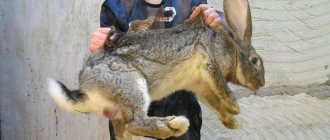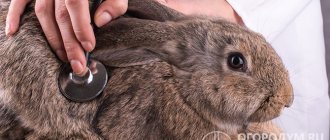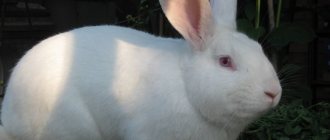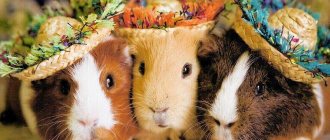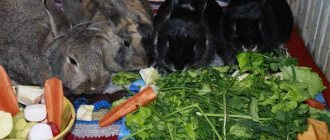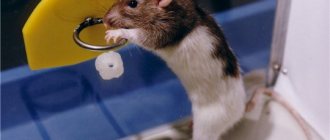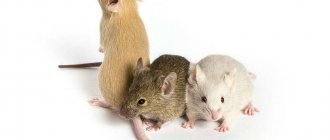How do rabbits behave?
Rabbits have many similarities in character and habits to cats. They also love to be petted and walk “on their own”: the little animal cannot be forced to do what it does not want. Fluffy pets do not like to be treated unceremoniously; they are offended if they are hurt or caused trouble. Like cats, they may not react to the presence of an offender for some time, bite or scratch, or even shit in an inappropriate place in retaliation.
The animals respond to the nickname, understand the intonation of the voice, gestures, and choose one owner for themselves - the family member who most often cares for the pet, pays attention to it, and pampers it. Domestic rabbits love communication and get bored if they don’t see people for a long time. A sign of trust in a person is permission to pat yourself on the stomach. When the animal feels good, it makes sounds - the rabbit cannot purr, but clicks its teeth.
It is easy to accustom pets to a cage, which they mistake for a house and enjoy spending time there. They relieve themselves in one corner of the cage - these are clean creatures. Maintain hygiene using the tongue.
Keeping a rabbit in an apartment causes some inconvenience. The big minus in his habits is that he chews everything that gets in his way: slippers, wallpaper, wires, furniture upholstery. A rabbit in an apartment, as in nature, is nocturnal - it runs around, stamping its paws, when its owners sleep. With age they become calmer. During puberty, their character changes, they become noisy, hooligan, mark their territory, and demand attention.
Reviews
Nadezhda, 33 years old, Moscow
Dwarf rabbits are a real miracle! They are very cute and pretty. Many people write that these animals can be trained, but I couldn’t. My little rabbit turned out to be wayward and goes about his business on walks, completely ignoring my attempts to tame him.
Anna, 20 years old, Ekaterinburg
We organized a cage for our decorative little lamb according to all the rules: we selected a spacious room, attached a hay holder, a special drinking bowl, a bowl, and even equipped a toilet. But the animal did not want to use it carefully; after 5 minutes the hay was scattered, the bowl was turned over, and he began to chew on the tray. I wonder if it was me who was so violent or if everyone is like this?
Marina, 41 years old, Omsk
I spent a long time choosing the breed of my future pet. I weighed all the pros and cons, comparing the conditions of detention, the appearance and character of the animals. In the end, I chose the Hermelins, and did not regret it. A very smart animal, it recognizes its owners and even responds to its name. At the same time playful and very cute! She enjoys sitting in her daughter's arms.
Gallery: decorative rabbits (25 photos)
Nutrition
Feeding rabbits is not difficult, but it does require some knowledge. Epidemics that have led to the death of entire farms are often caused by errors in animal nutrition. Nutrition is especially important when raising young rabbits. With insufficient nutrition, bloating and digestive problems immediately occur. This is the main cause of death by 4 months of age.
Rabbits use feed well (they give 1 kg of body weight gain with 3.5 kg of feed). In summer the main food is greens, in winter – hay and root vegetables. Concentrated feed in the form of cereals is also needed.
Rabbits can be fed agricultural feed. Cereals used from grain feeds are:
- barley;
- wheat;
- whole oats, crushed;
- corn;
- bran.
Grain is given to rabbits in dry form, without mixing with additives; food should always be prepared with milk or water. This prevents animals from throwing away food and protects against too rapid, harmful absorption of dry food. The mixture can be sprinkled with stewed, crushed beet puree.
Rabbits do not want to eat rye; care must be taken when feeding, since rye causes flatulence and diarrhea.
Legumes can be used in limited quantities in food:
- peas;
- beans;
- peas (shelling);
- sweet lupine.
The second, main and irreplaceable food is bulky dry and succulent food:
- hay;
- dried legumes;
- greens (wet and heated greens should not be given);
The hay is placed higher to prevent animals from contaminating it with feces.
Clover and alfalfa should be fed dry to rabbits. You can feed weeds - wormwood, burdock, wild horseradish leaves, wild chicory, dandelions (their milky juice is a real rabbit treat).
Leaves of different types of cruciferous plants should be given to rabbits in small quantities, they cause digestive problems.
Rabbits are also fed root vegetables:
- carrots – food, feed;
- fodder beet;
- swede;
- turnip;
- Jerusalem artichoke tubers;
- parsnip roots.
Steamed potatoes are of great value, especially for feeding in winter. Many people give the potatoes and skins raw, first sprinkling them generously with table salt. However, it is safer, especially in spring, to remove the green parts; they can easily cause poisoning with solanine contained in the green tissues of potatoes. The skins and potatoes should be thoroughly washed before feeding to remove any stubborn dirt that accumulates in the animal's gastrointestinal tract and can cause serious digestive problems.
You should remember to add vitamin-mineral mixtures. Rabbits can feed on pellets, although this is not the cheapest feeding method. Pelleted feeds are more commonly used on large beef farms. Complete feeds are balanced with all the nutrients necessary for growth and development - protein, energy, fiber, vitamins, minerals. Compound feed is provided in quantities corresponding to the physiological state, age and weight of the animal.
Concentrated feed in winter is the basis of rabbit nutrition. They contain a lot of carbohydrates, thanks to which animals can function normally and warm their bodies, and protein, which allows them to gain body weight. These feeds must be used during the breeding season, pregnancy, and milk feeding of rabbits.
Concentrated food has a positive effect on the quality of fur, accelerating its maturation and making it thick. Concentrates are called purchased granules or homemade feed mixtures, grains, legumes and oilseeds.
If you feed rabbits soft food, you need to insert twigs into the cages so that the animals can grind down their constantly growing teeth. You can give branches and leaves of certain trees:
- acacia;
- birch;
- willow;
- Linden;
- oak;
- maple;
- aspen;
- hazel;
- Rowan.
Branches of apple and pear trees obtained by cutting down trees are also given as an additive to feed. Rabbits readily eat the fruits of these trees; all this waste can be usefully given to animals in small quantities. Carrion from fruit trees is less suitable for food. Young shoots of conifers - spruce, pine, larch - are suitable for feeding.
Rabbits do not like poplar leaves, cherry shoots and leaves, plums and apricots are harmful to them, and peach shoots are poisonous!
To stimulate and regulate the digestion of rabbits, dried nettle leaves are as important as young plant shoots. After grinding, they are added in small quantities to soft food in winter.
Rabbits do not like sour grasses from marshy or peaty meadows.
Plants that are harmful to rabbits include:
- yew;
- juniper;
- boxwood;
- common privet;
- thuja;
- ivy;
- lily of the valley.
The better and more varied the animal eats, the healthier and more varied its food, the tastier the meat.
The frequency of feeding rabbits should not be too high, otherwise the animals will not eat the food well. In practice, animals are fed as follows:
- pregnant and lactating females and growing rabbits are fed three times a day;
- the rest - twice (morning and evening).
Rabbits are more active at night, so evening feeding should be more plentiful and include food that requires long-term digestion of food. In winter, animals are given:
- at night - hay, dried leaves, shoots;
- during the day - nourishing, juicy food.
Animals must have constant access to water through drinking bowls. Especially when using a large amount of dry food. When feeding formulas, water is necessary; it affects the absorption of nutrients. Rabbits have a rapid heartbeat, which means that water metabolism in the body is higher than in other animals. Water is of great importance during the feeding period; the female requires a lot of liquid to produce milk.
Decorative breeds
There are more than 200 breeds of decorative rabbits. They live 5-7 years, but with careful care their life is extended to 10 years.
How to care for rabbits depends on the characteristics of the breed. The following animals are most often bred:
- Colored dwarfs, or dwarf shorthairs. They got their name because of the variety of colors (more than 60 species), but white is considered the most beautiful. Until they are one and a half years old, they scratch and bite. To reduce aggression, castration is performed.
- Lion breeds (Lions). They are called so because a mane grows around the neck and head, like a lion. And even with their muzzle, some look like the king of beasts. This type is called Lion's Head. These are small animals, weighing no more than 1.2 kg. There are rabbits with long hair - the Angora lion. The fur hangs over the eyes and covers the ears. It needs to be trimmed regularly. Lions have such a calm character that it is safe for children to play with them.
- Dutch rabbits. They have an interesting color, shiny, soft wool. They weigh no more than 1 kg, but there is a separate species that grows up to 2-2.5 kg. The animals are obedient, smart and sociable, get along well with children, but are energetic and require increased attention. Easy to care for.
- Angora rabbits are fluffballs of two types. One has fur with a hair length of up to 20 cm, which feels like cotton wool to the touch. Your fur coat requires daily care. Another species has shiny fur that does not exceed 5 cm in length, which makes it easier to care for.
- Dwarf rexes. They grow up to 1.4 kg in weight. They have royal status. They are called plush for the quality of their wool. A fur coat of amazing beauty and a wide range of colors requires careful care. Smart, obedient, safe for children, easy to train. This makes caring for rabbits easy and enjoyable.
- Fold sheep are cute, harmless animals with a good character. They have a head similar to a lamb, long hanging ears (22-27 cm), due to which they have difficulty hearing. Thanks to this, they are extremely calm and fearless, which is why keeping decorative rabbits of this breed is recommended for families with small children. Caring for them is easy.
What should a rabbitry be like?
A place for breeding rabbits in a country house or plot is a rabbitry, most often a wooden structure in the form of an old cabinet, which consists of individual wooden cages or the structure itself is divided into smaller cages.
Playpens are usually constructed of mesh and the animals are divided into groups.
Arrangement of the cage
The cells must be:
- dry,
- clean,
- light,
- sealed.
Outdoor cages should be covered - rabbits do not like rain, harsh light, and should not be kept in the sun.
To ensure effective urine flow, a double floor is made. The lower floor should be sealed and slightly sloping, the upper floor should be secured with slats spaced 1.5 cm apart. In winter, a large amount of bedding should be provided.
Rabbits require cages of the appropriate size. When choosing cells, you need to take into account the specialization of selection (skins/meat) and the breed of animals.
The figure shows the dimensions for keeping 1 rabbit. When keeping in groups, the cage size should be increased in proportion to the number of animals kept. It is optimal to keep 2-3 animals in a cage, which allows you to strengthen control in the herd, easily monitor diseases, and respond to aggressive behavior.
When raising rabbits for meat, it is better to keep them in large cages to ensure a lot of movement, which has a positive effect on the quality of the meat. It is important to group animals by breed, age, and gender. This prevents rabbit cannibalism and biting.
A large number of animals in a cage increases the number of pathologies by 15%, leading to excessive obesity of animals.
Adult males should be kept in separate cages or boxes. Each of them should have his own cage where he will feel safe. The male's cage should be located away from the females, the smell of which can stimulate the male to constant activity; he will waste energy unproductively, trying to get out of the cage. It is best to place the males' cages in a separate room or outdoors, away from the rest of the nursery. If this is difficult to do, cages should be placed to the side of a large group of cages or on the top floor.
The separation of animals is also aimed at limiting the spread of pathogens and the possibility of using a different feeding system.
Manure should be removed, cages cleaned, disinfected weekly, then re-lined with fresh straw. This will keep the animals healthy. Rabbit manure can be used as fertilizer.
Temperature, lighting, humidity
Animals need to be provided with:
- access to light
- optimal temperature,
- required humidity.
It is important to provide animals with good air access. If you are serious about rabbits, you will need summer and winter cages (located indoors).
Rabbits need access to natural or artificial light. Light is an important factor affecting the reproduction of rabbits. The cages need to be equipped with feeders, drinking bowls, and houses for females.
In winter, it is necessary to provide a large amount of bedding and access to light: 14-16 hours a day.
Optimal room temperature:
- for females with cubs – 18 g. C, as the animals grow, the temperature can be reduced;
- adult individuals can be kept at a temperature of 12-14 degrees C.
Humidity should be about 65%; too low humidity can cause dry mucous membranes, reducing the resistance of animals to diseases of the respiratory system.
Ventilation
Gravity ventilation and room ventilation are usually used. Ventilation serves to remove moisture and harmful gases that threaten the health of animals. It is important not to create drafts and that the cages do not stand in a direct line to the fresh air intake.
Keeping rabbits
How to keep a rabbit? This is the daily work and attention that a furry pet requires. Sometimes maintaining them involves unpleasant troubles. Keeping decorative rabbits at home can be done by someone who is not afraid of worries, is ready to forgive pets for their pranks and put up with certain inconveniences. To care for and maintain decorative rabbits you need the following equipment:
- A large, comfortable cage with a solid floor, because the structure of the legs does not allow free movement on the grid. Cover the corner of the cage or place a box for the pet to hide there.
- Aviary, if walks around the apartment are not provided.
- A drinking bowl or feeder is preferably heavy, for example ceramic, so that the eater who likes to scatter food does not turn it over with his teeth. A plastic feeder is attached to the cage. Container for storing hay.
- A tray with litter, a scoop and vinegar to neutralize urine odor.
- A thick branch for a rabbit to sharpen its teeth.
- Scissors - cut nails, combs and grooming brushes.
- Toys to chew on instead of furniture.
Your furry friend's cage should not be placed near a window, close to a heating radiator, or in a draft. The animal is kept at average room temperature, because the animal cannot tolerate heat or high humidity. For this reason, rabbits do not need water treatments: they independently maintain the cleanliness of their fur coat.
Caring for rabbits at home does not require special knowledge, although the animals are gentle, have weak immunity and are susceptible to diseases.
Caring for rabbits at home does not require special knowledge
First meeting
All you need to know about decorative rabbits is that they are quite shy. Therefore, when meeting for the first time, there is no need to immediately try to cuddle or stroke the animals. Like any other pet, babies need to get comfortable, get used to it, and adapt. If you suddenly rush at him with expressions of love, the rabbit will simply get scared and hide in a corner.
It would be better to carefully and slowly reach out to him and treat him with some goodies. It can be vegetables, fruits.
You need to talk to the rabbit in a gentle, quiet and calm voice - this way he will quickly understand that the new owner does not pose a danger to him.
Furry pet care
Those who want to have a furry pet are primarily interested in how to properly care for rabbits so that the animals grow healthy, reproduce, and do not create problems and discomfort for their owners. Looking after rabbits at home is as follows:
- Feeding. The diet must contain the necessary components. You should not overfeed - this causes obesity, which has a bad effect on health and reproductive abilities.
- Cleaning the cells. The presence of an unpleasant odor in the house depends on how to care for domestic rabbits. The feeder and tray are washed daily. The cage itself is cleaned once a week. Cleaning and disinfection are carried out every month.
- Caring for decorative rabbits involves combing the fur and cutting it. This is done regularly so that the fur does not settle on the floor, furniture and does not accumulate in the stomach of the little tidy. Rabbits are bathed only in exceptional cases.
- Trimming nails is a mandatory procedure, because they grow, and the rabbit grinds them down on furniture, walls, and scratches painfully. Shorten the claws carefully so as not to damage the blood vessels.
- Vaccination. Animals are susceptible to the same diseases as ordinary rabbits. The most dangerous diseases are myxomatosis (spread by mosquitoes) and viral hemorrhoidal disease. They give a mortality rate of 70-100%. The first vaccination is carried out at the age of 28-45 days, and then once a year. If necessary, vaccinations are given against pasteurellosis, paratyphoid fever, rabies, etc.
- Deworming. Held every quarter.
Weaning from a female rabbit
The digestive system of newborn rabbits is very vulnerable, and it is recommended to wean them no earlier than one and a half months. At this age, they can easily endure separation from their mother rabbit because they are not attached to their mother’s milk.
Sometimes farmers are forced to shift deadlines. For example, if a female becomes pregnant immediately after giving birth, and the offspring will be born a month after the previous birth. In this case, the young animals are removed on the 28th day so that the mother can regain strength before the appearance of newborn rabbits.
Important! Broiler babies must be with their mother for up to 60 days. The life of such rabbits is short-lived: they are slaughtered soon after leaving the female.
Buying a rabbit
Breeding decorative rabbits brings not only the pleasure of interacting with interesting animals, but also good money. Animals begin to reproduce at 6-7 months. The female brings 4-6 rabbits every 3 months, and at the age of 1-3 months they are already sold. They cost more than regular breeds.
To buy a healthy animal, it is better to contact a breeder or a rabbit nursery, where they will tell you how to care for a decorative rabbit. When purchasing, the following is taken into account:
- Age. Up to 1 month, the baby rabbit feeds on its mother’s milk, and the older the baby rabbits, the more difficult it is for them to get used to their new owners and show aggression. In a three-month-old rabbit, the characteristics of the breed are already clearly expressed, and the sex is determined.
- Clean butt: so that there are no signs of diarrhea or discharge from the genitals.
- Clean nose, eyes, ears.
- The appearance of the fur is clean, smooth, shiny.
- Animal behavior. If he sits with a ruffled look, it means that not everything is all right with him.
- Correct bite. If the bite is incorrect, the teeth will not grind down, and this will place an additional burden on the owner: they will have to be trimmed constantly.
If the animal walks in your arms, is not afraid and does not show aggression, you can safely buy it - this is your rabbit.
Common diseases
Decorative dwarf rabbits are fragile and delicate creatures, susceptible to stress and a large number of diseases. However, with proper care and timely contact with a veterinarian, almost any ailment can be treated.
Owners need to be careful and alert if:
- the animal hides, hides in a corner and other places unusual for it;
- the coat looks disheveled and dull and begins to shed;
- appetite worsens;
- there is diarrhea or constipation;
- discharge appears from the eyes or nose.
At the first alarming symptoms, it is better not to self-treat, but to immediately show your pet to a veterinarian
Stomach upset
The most vulnerable part of a rabbit’s body is the stomach. Therefore, any disturbances in the animal’s diet can lead to digestive disorders, primarily diarrhea.
Stomach upset is most often caused by:
- eating moldy bread or dry food;
- entering the diet of food affected by pests, for example, weevils;
- sudden change in diet;
- eating excess amounts of vegetables and fruits;
- viral infections;
- pathologies of the digestive system;
- unsanitary conditions in the cage.
As first aid for diarrhea, you can do the following:
- Give the animal a chamomile solution prepared according to the instructions. Dilute the resulting product at the rate of 0.5 tbsp. l. decoction for 1 tbsp. l. water and give three times a day for a week. If the rabbit refuses to drink on its own, you can forcefully pour the product into the mouth using a syringe without a needle.
- Clean and disinfect the cage well. Lay down new bedding.
- Remove all food, vegetables and fruits from the diet, feed only hay and give water.
If the diarrhea does not go away within one or two days, you should immediately consult a veterinarian.
Paralysis
Paralysis often affects the hind limbs and lower spine. The rabbit becomes inactive and lies on its side. This condition leads to constipation and poses a high risk to the life of the animal.
It is known that the disease is easier to prevent than to treat. For the purpose of prevention, it is necessary to ensure that the rabbit does not jump from a height (sofa, table and other furniture), and also does not slip on a smooth surface. In addition to traumatic causes, paralysis can be caused by a lack of vitamins and microelements, as well as infectious diseases. At the first symptoms of the disease, you should consult a specialist.
Rhinitis
As mentioned above, rabbits are very sensitive to drafts and do not tolerate unfavorable environmental conditions. Due to decreased immunity, bacteria develop in animals' bodies, causing runny noses and sneezing. Long-term illness leads to profuse discharge from the eyes and nose, weight loss, and loss of shine in the coat.
From the following video you can learn how and with what to treat a runny nose in rabbits:
Harmful products
Some products are of little benefit and are even toxic to decorative rabbits. These include:
- store-bought food for birds and rodents;
- corn, dried peas, beans;
- boiled vegetables, greens;
- sweets, baked goods;
- bread, porridge, muesli;
- nuts;
- onion;
- sorrel;
- lemon;
- avocado;
- sweet fruits.
It is important to keep the cage and equipment clean, and clean the tray regularly. You should change the water daily, add fresh food, and monitor the amount of hay consumed. Long-haired breeds of decorative rabbits require daily brushing. Bathing is extremely stressful for rabbits, so water procedures are carried out in case of emergency.
When getting rabbits, you need to understand the full responsibility for the health and life of the pet. Decorative rabbits are sensitive and require careful handling; they need to be cared for with love. Nutrition plays a big role in the quality of life. A properly formulated diet and proper feeding are the key to successful and long-term maintenance.
Diseases and their treatment
Rabbits often get sick. When raising rabbits, it is necessary to observe preventive measures to prevent diseases:
- disinfection of cells and equipment;
- vaccination against viral diseases (vaccinations against myxomatosis and rabbit distemper are mandatory).
Diseases of rabbits are divided into:
- infectious-viral;
- bacterial and invasive;
- non-infectious, caused by physical factors - fractures, bites, poisoning.
Myxomatosis
A dangerous disease of rabbits that is subject to mandatory control. Infection occurs through:
- contact of healthy animals with sick ones;
- infected equipment;
- after being bitten by mosquitoes carrying the disease.
The first symptoms of the disease appear 2-5 days after infection. Symptoms include:
- conjunctivitis;
- watery eyes;
- swelling of the ears, head, limbs, lower abdomen, external genitalia.
Sick rabbits are not treated; healthy ones are vaccinated prophylactically; cages and premises are protected from mosquitoes from July to October.
Rabbit Plague
A viral disease characterized by an extremely acute course. Within 48 hours, in some cases 18 hours after infection, the death of all rabbits in the herd occurs. 2-3 hours before death, severe weakness, shortness of breath are observed, a serous runny nose appears, and the rabbits make sudden movements. Sick rabbits are not treated.
Prevention - vaccination of rabbits at the time of weaning from females, repeated vaccination is done after 6 months if they remain for further reproduction.
Pasteurellosis
Bacterial diseases include pasteurellosis, caused by Pasterella multocida bacteria, which live in the respiratory tract of every healthy rabbit, causing no harm under favorable conditions. The disease begins with a runny nose and eyes, and the mucus becomes purulent as the disease progresses.
Rabbits cough, sneeze, have difficulty breathing, and die from suffocation. The disease can have an acute or chronic course. Treatment includes the use of antibiotics, sulfonamides, and serums.
Coccidiosis
The parasitic disease caused by protozoa of the genus Eimeria can take an intestinal or hepatic form. Infection occurs through the gastrointestinal tract; young rabbits are more likely to get sick, immediately after weaning. Sick animals are drowsy, apathetic, do not eat, and diarrhea appears, leading to dehydration and death. Treatment includes administration of medications recommended by veterinarians.
Raising rabbits can be a good activity for rural residents, providing healthy, tasty meat and a satisfying business. Raising rabbits in the backyard is an additional source of income, it is not difficult if you provide them with the proper conditions and protect them from mistakes.
Not only valuable fur
- meat is dietary, cholesterol-free, recommended for cardiovascular diseases and allergies. Suitable for diabetics and gout patients as it does not contain purine compounds.
- The fat is used as a rub for coughs. In cosmetology it serves as the basis for creams and masks.
- Down is hypoallergenic and is often used to make children's clothing.
- Manure is rich in microelements comparable to horse manure and increases plant productivity almost tenfold.
At Lena LENIN's party, Nikolai BASKOV was given a rabbit, which he grabbed by the ears so hard that he broke the poor man's cervical vertebrae. Before this, Lenina herself killed a kitten, which she painted pink. The animal died due to intoxication

